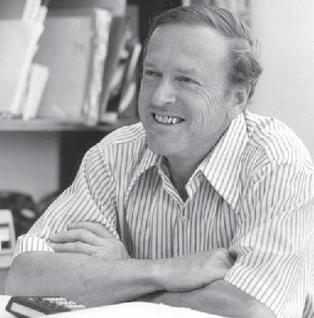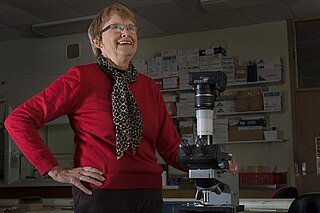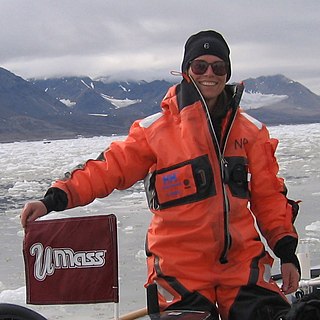
Thomas Gold was an Austrian-born American astrophysicist, a professor of astronomy at Cornell University, a member of the U.S. National Academy of Sciences, and a Fellow of the Royal Society (London). Gold was one of three young Cambridge scientists who in 1948 proposed the now mostly abandoned "steady state" hypothesis of the universe. Gold's work crossed boundaries of academic and scientific disciplines, into biophysics, astronomy, aerospace engineering, and geophysics.

The Kola Superdeep Borehole SG-3 is the deepest human-made hole on Earth, which attained maximum true vertical depth of 12,262 metres in 1989. It is the result of a scientific drilling effort to penetrate as deeply as possible into the Earth's crust conducted by the Soviet Union in the Pechengsky District of the Kola Peninsula, near the Russian border with Norway.
The abiogenic petroleum origin hypothesis proposes that most of earth's petroleum and natural gas deposits were formed inorganically, commonly known as abiotic oil. Scientific evidence overwhelmingly supports a biogenic origin for most of the world's petroleum deposits. Mainstream theories about the formation of hydrocarbons on earth point to an origin from the decomposition of long-dead organisms, though the existence of hydrocarbons on extraterrestrial bodies like Saturn's moon Titan indicates that hydrocarbons are sometimes naturally produced by inorganic means. A historical overview of theories of the abiogenic origins of hydrocarbons has been published.

The Deep Sea Drilling Project (DSDP) was an ocean drilling project operated from 1968 to 1983. The program was a success, as evidenced by the data and publications that have resulted from it. The data are now hosted by Texas A&M University, although the program was coordinated by the Scripps Institution of Oceanography at the University of California, San Diego. DSDP provided crucial data to support the seafloor spreading hypothesis and helped to prove the theory of plate tectonics. DSDP was the first of three international scientific ocean drilling programs that have operated over more than 40 years. It was followed by the Ocean Drilling Program (ODP) in 1985, the Integrated Ocean Drilling Program in 2004 and the present International Ocean Discovery Program in 2013.

The San Andreas Fault Observatory at Depth (SAFOD) was a research project that began in 2002 aimed at collecting geological data about the San Andreas Fault for the purpose of predicting and analyzing future earthquakes. The site consists of a 2.2 km pilot hole and a 3.2 km main hole. Drilling operations ceased in 2007. Located near the town of Parkfield, California, the project installed geophone sensors and GPS clocks in a borehole that cut directly through the fault. This data, along with samples collected during drilling, helped shed new light on geochemical and mechanical properties around the fault zone.
The Integrated Ocean Drilling Program (IODP) was an international marine research program, running from 2003 to 2013. The program used heavy drilling equipment mounted aboard ships to monitor and sample sub-seafloor environments. With this research, the IODP documented environmental change, Earth processes and effects, the biosphere, solid earth cycles, and geodynamics.
Scientific drilling into the Earth is a way for scientists to probe the Earth's sediments, crust, and upper mantle. In addition to rock samples, drilling technology can unearth samples of connate fluids and of the subsurface biosphere, mostly microbial life, preserved in drilled samples. Scientific drilling is carried out on land by the International Continental Scientific Drilling Program (ICDP) and at sea by the Integrated Ocean Drilling Program (IODP). Scientific drilling on the continents includes drilling down into solid ground as well as drilling from small boats on lakes. Sampling thick glaciers and ice sheets to obtain ice cores is related but will not be described further here.
The EarthScope Consortium operates the Seismological Facility for the Advancement of Geoscience (SAGE) which manages some of the Global Seismographic Network stations and the Geodetic Facility for the Advancement of Geoscience (GAGE) which operates the Network of the Americas (NOTA). The EarthScope Consortium represents the merger of the former Incorporated Research Institutions for Seismology (IRIS) and UNAVCO efforts and continues a portion of the EarthScope project which concluded in March 2022.

Chikyū (ちきゅう) is a Japanese scientific drilling ship built for the Integrated Ocean Drilling Program (IODP). The vessel is designed to ultimately drill 7 km beneath the seabed, where the Earth's crust is much thinner, and into the Earth's mantle, deeper than any other hole drilled in the ocean thus far.

Travelling to the Earth's center is a popular theme in science fiction. Some subterranean fiction involves traveling to the Earth's center and finding either a Hollow Earth or Earth's molten core. Planetary scientist David J. Stevenson suggested sending a probe to the core as a thought experiment. Humans have drilled over 12 kilometers in the Sakhalin-I project. In terms of depth below the surface, the Kola Superdeep Borehole SG-3 retains the world record at 12,262 metres (40,230 ft) in 1989 and still is the deepest artificial point on Earth.
In 2017 the department was merged with the Department of Geology and Mineral Resources Engineering, forming the new Department of Geoscience and Petroleum.
The International Generic Sample Number or IGSN is a persistent identifier for sample. As an active persistent identifier it can be resolved through the Handle System. The system is used in production by the System for Earth Sample Registration (SESAR), Geoscience Australia, Commonwealth Scientific and Industrial Research Organisation Mineral Resources, Australian Research Data Commons (ARDC), University of Bremen MARUM, German Research Centre for Geosciences (GFZ), IFREMER Institut Français de Recherche pour l'Exploitation de la Mer, Korea Institute of Geoscience & Mineral Resources (KIGAM), and University of Kiel. Other organisations are preparing the introduction of the IGSN.
UNAVCO (University Navstar Consortium) was a non-profit university-governed consortium that facilitated geology research and education using geodesy.
The European Consortium for Ocean Research Drilling (ECORD) is a consortium of 14 European countries and Canada that was formed in 2003 to join the Integrated Ocean Drilling Program (IODP) as a single member. ECORD is now part of the International Ocean Discovery Program, which addresses crucial questions in Earth, Ocean, Environmental and Life sciences based on drill cores, borehole imaging, observatory data, and related geophysical imaging obtained from beneath the ocean floor using specialized ocean-going drilling and research vessels and platforms. As a contributing member of IODP, ECORD is entitled to berths on every IODP expedition.

The German Continental Deep Drilling Programme, abbreviated as the KTB borehole, was a scientific drilling project carried out from 1987 to 1995 near Windischeschenbach, Bavaria. The main super-deep borehole reached a depth of 9,101 m in the Earth's continental crust.
The Deep Carbon Observatory (DCO) is a global research program designed to transform understanding of carbon's role in Earth. DCO is a community of scientists, including biologists, physicists, geoscientists and chemists, whose work crosses several traditional disciplinary lines to develop the new, integrative field of deep carbon science. To complement this research, the DCO's infrastructure includes public engagement and education, online and offline community support, innovative data management, and novel instrumentation development.
The International Ocean Discovery Program (IODP) is an international marine research collaboration dedicated to advancing scientific understanding of the Earth through drilling, coring, and monitoring the subseafloor. The research enabled by IODP samples and data improves scientific understanding of changing climate and ocean conditions, the origins of ancient life, risks posed by geohazards, and the structure and processes of Earth's tectonic plates and uppermost mantle. IODP began in 2013 and builds on the research of four previous scientific ocean drilling programs: Project Mohole, Deep Sea Drilling Project, Ocean Drilling Program, and Integrated Ocean Drilling Program. Together, these programs represent the longest running and most successful international Earth science collaboration.

Elizabeth Marchant Truswell is a former Chief Scientist at the Australian Geological Survey Organisation and is known for her application of recycled palynomorph distribution as an indicator of sub-ice geology.

Julie Brigham-Grette is a glacial geologist and a professor in the Department of Geosciences at the University of Massachusetts Amherst where she co-directs the Joseph Hartshorn Quaternary Laboratory. Her research expertise is in glacial geology and paleoclimatology; she has made important contributions to Arctic marine and terrestrial paleoclimate records of the late Cenozoic to recent periods, the evolution of the Arctic climate, especially in the Beringia/Bering Strait region, and was a leader of the international Lake El’gygytgyn Drilling Project in northeastern Russia.
The deep biosphere is the part of the biosphere that resides below the first few meters of the surface. It extends down at below 10 kilometers below the continental surface and 21.0 kilometers below the sea surface, at temperatures that may reach beyond 120 °C (248 °F) which is comparable to the maximum temperature where a metabolically active organism has been found. It includes all three domains of life and the genetic diversity rivals that on the surface.








